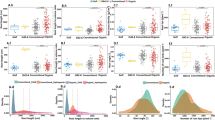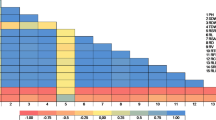Abstract
-
1.
A number of varieties of cultivated juteGorchorus oHtorius L. andG. capsularis L. were tested in artificially created drought, waterlogging and control conditions.
-
2.
The number of lateral roots with secondary growth was reduced to the minimum inC. capsularis under waterlogged conditions, but the weight of the roots was increased to the maximum, due to the production of numerous spongy and fibrous roots.C. olitorius suffered in both the characters under similar environment and failed to produce fibrous and spongy root. This species gained in root weight and lateral root number in drought under whichC. capsularis suffered in these two characters. These were the main features of adaptation of these two species.
-
3.
Within species among varieties the variations regarding these two characters have been found to be controlled by genotypes. Lateral root number within both the species has been found to be a more strongly heritable character than root weight. Expected genetic advance has revealed the scope of selection for lateral root number.
-
4.
While variations among thé varieties within species have been interpreted as an expression of phenotypic flexibility, the variation between species is an expression of phenotypic plasticity, which is an outcome of basically physiological mechanisms.Corchorus capsularis L. andC. olitorius L. are two cultivated jute species. The most striking distinction between these two species hitherto known is that whileG. capsularis can withstand waterlogging successfully,C. olitorius cannot. This general view formed the basis of testing these species under artificially created environmental stresses to find out the general components contributing to this specific difference.
Abstract
-
1.
Autori testovali několik odrůd kulturnich jutCorchorus olitorius L. acapsularis L. v uměle navozeném suchu, zamokřeni a za kontrolních podmínek.
-
2.
V podmínkách zamokřeni se pocet postrannich korenů, schopnych sekundárního růstu, ucapsularis snízil na minimum, zvysila se vsak vaha korenů diky vzniku mnoha vláknitych a houbovitych kofenu.C. olitorius za těchze podmínek stradai v obou znacích a neprodukoval vláknité a houbovité koreny. Pro zvysení poctu postrannich kofenů a celkovou vláhu kofenú tohoto druhu bylo velmi pfíznivé sucho, které se naopak ukázalo jako nevhodné pro tytéz znaky uC. capsularis Uvedené charakterisovalo adaptibilitu sledovanych druhů.
-
3.
Bylo zjistěno, ze mezi odmdami v rámci téhoz druhu je variabilita obou sledovanych znaků kontrolována genotypem Pocet postrannich kofenů u obou druhů byl shledán silněji dědivym znakem nez vaha kofenů. Ocekávan^ geneticky1 vytězek ukázal směr selekce na pocet postrannich kofenú.
-
4.
Zatímco variabilita mezi odrůdami téhoz druhu byla interpretována jako vyraz fenotypové flexibility, je variabilita mezi druhy vyrazem fenotypové plasticity, která je podminěna v pod-statě fysiologickymi mechanismy.
Abstract
-
1.
Испытано несколько сортов джута Corchorus olitorius L. и С. capsularis L. при искусственной засухе, в условиях избыточного увлажнения почвы и в контрольных условиях.
-
2.
В условиях избыточного увлажнения количество боковых корней, способных к вторичному росту, у С. capsularis снизилось к минимуму, однако повысился вес корней благодаря образованию большого количества волокнистых и губчатых корней. У С. olitorius в тех же условиях были понижены оба признака, и волокнистые губчатые корни не образовывались. На повышение количества боковых корней и на общий вес корней этого вида благоприятно подействовала засуха. На те же признаки вида С. capsularis засуха действовала, наоборот, неблагоприятно. Приведенные результаты характеризуют способность к адаптации у исследованных сортов.
-
3.
Было установлено, что в рамках одного и того же вида изменчивость обоих исследованных признаков у сортов контролируется генотипом. Количество боковых корней у обоих видов оказалось сильнее наследуемым признаком, чем вес корней. Ожидаемый генетический выход показал направление селекции по признаку количества боковых корней.
-
4.
В то время как изменчивость между сортами одного и того же вида была объяснена как следствие фенотипической гибкости, межвидовая изменчивость является следствием фенотипической пластичности, обусловленной, в основном, физиологически.
Similar content being viewed by others
References
Allard, W., Bradshaw, A. D.: Implications of genotype — environmental interaction in applied plant breeding. - Crop Science4: 503–507, 1964.
Bradshaw, A. D.: Evolutionary significance of phenotypic plasticity in plants. - Adv. Genet.13: 115–155, 1965.
Johnson, H. W., Robinson, H. F., Comstock, R. E.: Estimates of genetic and environmental variability in soybeans. - Agron. J.47: 314–318, 1955.
Panse, V. G.: Genetics of quantitative characters in relation to plant breeding. - Indian J. Genet.17: 318–328, 1957.
Steward, F. C., Mapes, O. M., Mears, K.: Growth and organized development of cultures cells, II: Organization in cultures grown from freely suspended cells. Molecular and cellular aspect of development.- Harper & Row, Publishers, New York, Evanston, and London, pp 155 to 160, 1965.
Thoday, J. M.: Components of fitness. - Symp. Soc. Exptl. Biol.7: 96–113, 1953.
Author information
Authors and Affiliations
Rights and permissions
About this article
Cite this article
Basak, S.L., Chaudhuki, B.B. Genetic variation and phenotypic plasticity of roots in two cultivated species of jute (Corchorus olitorus L. andC. capsularis L.). Biol Plant 9, 292–300 (1967). https://doi.org/10.1007/BF02929770
Received:
Issue Date:
DOI: https://doi.org/10.1007/BF02929770




